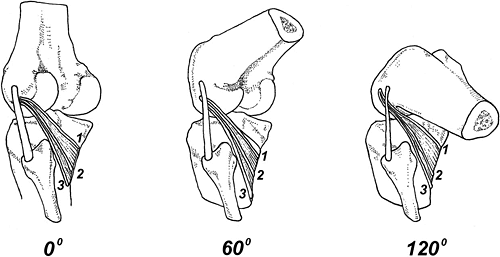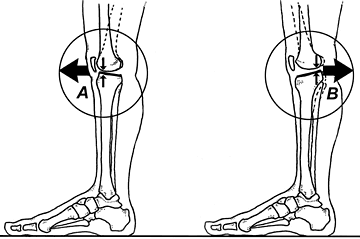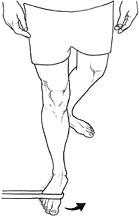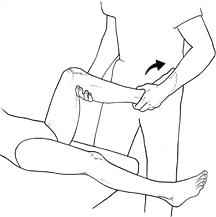The popliteus muscle originates from the lateral aspect of the distal femur and inserts along the posterior aspect of the proximal tibia. It is comprised of three separate fiber bundles that are under different degrees of tension, depending upon the degree of knee flexion.
In addition to providing static stability, the popliteus muscle is also a significant dynamic stabilizer. During the gait cycle, in addition to unlocking the knee during the contact period, this muscle helps maintain postural equilibrium by controlling subtle transverse and frontal plane knee-joint moments.2 It also stabilizes the lateral meniscus by lessening the potential for impingement -- drawing the lateral meniscus posteriorly during flexion of the knee.

 Fig. 2. Normally, the tibial plateau tilts backward slightly, creating a flexion moment at the knee (A). In some individuals, the tibial plateau is flat or even tilted anteriorly, increasing the likelihood for developing genu recurvatum (B).
While running, the popliteus is most likely tensing during midstance as the knee transitions from full knee flexion to extension. An EMG analysis of popliteus activity during squat maneuvers3 reveals that this muscle is most active with the transition from full flexion into extension, when it acts to prevent forward translation of the femur on the tibia. Its role in preventing forward femoral translation is especially important while walking and running downhill.
Fig. 2. Normally, the tibial plateau tilts backward slightly, creating a flexion moment at the knee (A). In some individuals, the tibial plateau is flat or even tilted anteriorly, increasing the likelihood for developing genu recurvatum (B).
While running, the popliteus is most likely tensing during midstance as the knee transitions from full knee flexion to extension. An EMG analysis of popliteus activity during squat maneuvers3 reveals that this muscle is most active with the transition from full flexion into extension, when it acts to prevent forward translation of the femur on the tibia. Its role in preventing forward femoral translation is especially important while walking and running downhill.
The most common biomechanical factors responsible for the development of popliteus tendinitis are genu varum and genu recurvatum. (Fig. 2) The varus knee is more likely to strain the popliteus when the hip abductor musculature is weak, while genu recurvatum is more likely to strain the popliteus muscle when the hamstrings and/or gastrocnemius muscles are weak.
 Fig. 3. Popliteus exercise. The knee is maintained in a fixed and slightly flexed position while the forefoot is adducted by internally rotating the lower leg (arrow).
As a result, in addition to strengthening the popliteus muscle with the exercises illustrated in Fig. 3, it is also important to evaluate strength in the muscular synergists to the popliteus. Because this muscle is difficult to stretch, popliteus responds best to deep-tissue massage followed with the hold/relax stretch illustrated in Fig. 4. When performing massage, it is important to isolate all three bundles of the popliteus muscle. Finally, because popliteus plays an important role in maintaining postural equilibrium, it is important to include agility drills, such as backward and grapevine running.
Fig. 3. Popliteus exercise. The knee is maintained in a fixed and slightly flexed position while the forefoot is adducted by internally rotating the lower leg (arrow).
As a result, in addition to strengthening the popliteus muscle with the exercises illustrated in Fig. 3, it is also important to evaluate strength in the muscular synergists to the popliteus. Because this muscle is difficult to stretch, popliteus responds best to deep-tissue massage followed with the hold/relax stretch illustrated in Fig. 4. When performing massage, it is important to isolate all three bundles of the popliteus muscle. Finally, because popliteus plays an important role in maintaining postural equilibrium, it is important to include agility drills, such as backward and grapevine running.
 Fig. 4. Hold / relax stretch of the popliteus muscle. The examiner stabilizes the proximal tibia while the patient isometrically tenses the popliteus muscle. Upon relaxing the muscle, the examiner stretches the popliteus by abducting the forefoot (arrow).
On rare occasions, the popliteus muscle may be so tight that it snaps back and forth over a bony projection near the base of the popliteus sulcus.4 The chronic snapping, which occurs when the knee is flexed 20° to 30°, is accentuated by varus stress and may result in chronic pain that does not respond to conservative intervention. In such cases, surgical tenodesis of the popliteus tendon to the lateral collateral ligament stabilizes the proximal tendon and produces excellent long-term outcomes.4
Fig. 4. Hold / relax stretch of the popliteus muscle. The examiner stabilizes the proximal tibia while the patient isometrically tenses the popliteus muscle. Upon relaxing the muscle, the examiner stretches the popliteus by abducting the forefoot (arrow).
On rare occasions, the popliteus muscle may be so tight that it snaps back and forth over a bony projection near the base of the popliteus sulcus.4 The chronic snapping, which occurs when the knee is flexed 20° to 30°, is accentuated by varus stress and may result in chronic pain that does not respond to conservative intervention. In such cases, surgical tenodesis of the popliteus tendon to the lateral collateral ligament stabilizes the proximal tendon and produces excellent long-term outcomes.4
References
- LaPrade R, Wozniczka J, Stellmaker M, et al. Analysis of the static function of the popliteus tendon in the evaluation of an anatomic reconstruction. Am J Sports Med, 2010;38:543.
- Parado Reis F, Ferraz de Carvalho CA. Electromyographic study of the popliteus muscle. Electromyogr Clin Neurophysiol, 1973;13:445-455.
- Schinman M, Bijak M, Unger E, et al. Electromyographic study of the popliteus muscle in the dynamic stabilization of the posterolateral corner structures of the knee. Am J Sports Med, 2011;39:173.
- Cooper D. Snapping popliteus tendon syndrome: a cause of mechanical knee popping in athletes. Am J Sports Med, 1990;27:671.
Click here for more information about Thomas Michaud, DC.





